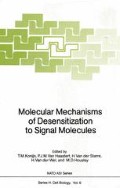Abstract
The main features of the visual phototransduction process, through which light initiates changes of ionic conductance in the retinal rod cell membrane, are now elucidated: cGMP is the soluble transmitter molecule, between the intracellular disk membrane where the light catching pigments are embedded, and the cell membrane which contains the ionic channels. Illumination of rhodopsin results in a fast and intense activation of a cGMP phosphodiesterase. cGMP controles directly the conductance of the cell membrane channels to which it binds. No cyclic nucleotide dependent kinase is involved. This is now the best documented example of a transduction mechanism between a membrane receptor protein (rhodopsin) and membrane bound effectors of cyclic nucleotides (cGMP phosphodiesterase), mediated by a special type of G protein, transducin (see 1 and 2 for recent reviews). It is the archetype of G protein mediated transduction.
Access this chapter
Tax calculation will be finalised at checkout
Purchases are for personal use only
Preview
Unable to display preview. Download preview PDF.
References
M. CHABRE, Trigger and amplification mechanism in visual phototransduction. Ann. Rev. Biophys. Biophys. Eng. 14, 331–360 (1985).
L. STRYER, Cyclic GMP cascade of vision. Ann. Rev. Neurosci. 9, 87–119 (1986).
M. CHABRE, C. PFISTER, P. DETERRE AND H. KÜHN, The mechanism of control of cGMP phosphodiesterase by photoexcited rhodopsin. Analogies with Hormone controlled systems in Hormone and Cell regulation. Vol. 8, p. 87–98, J. DUMONT and J. NUNEZ ed. Elsevier (1984).
R.A. DIXON et al., cloning of the gene and cDNA for mammlian 3 adrenergic receptor and homology with rhodopsin. Nature 321, 75–79 (1986).
J.L. BENOVIC, R.A. STRASSER, M.G. CARON AND R. LEFKOWITZ, ß adrenergic receptor kinase: identification of a novel protein kinase that phosphorylates the agonist occupied form of the receptor. Proc. Natl. Acad. Sc. US 83, 2797–2801 (1986).
B.K.K. FUNG AND C.R. NASH, Characterization of transducin from bovine rod outer segments J. Biol. Chem. 258 10495–10510 (1983)
H. STIEVE (editor), “The molecular mechanism of photoreception”. Dahlem Konferenzen Life Science report 34 (1986). Papers by T.D. LAMB and by E.G. PUGH.
B.A. BAYLOR, B.J. NUNNS AND J.L. SCHAPF, the photocurrent, noise and spectral sensitivity of the monkey. J. Physiol. 357, 575–607 (1984).
P.A. LIEBMAN AND E.N. PUGH, ATP mediates rapid reversal of cyclic GMP phosphodiesterase activation in photoreceptor membranes. Nature 287, 734–736 (1980).
C. PFISTER, M. CHABRE, J. PLOUET, V.V. TUYEN, Y. DE KOZAK, J.P. FAURE and H. KÜHN, Retinal S antigen identified as the 48K protein regulating light dependent phosphodiesterase in rods. Science, 228, 891–893 (1985).
J.B. HURLEY and L. STRYER, Purification and characterization of the y regulatory subunit of the cyclic GMP phosphodiesterase from retinal rod outer segments. J. Biol. Chem. 257, 11094–11099 (1982).
T.G. WENSEL and L. STRYER, Reciprocal control of rod cyclic GMP phosphodiesterase by its y subunit and transducin. In press (1986).
P. DETERRE, J. BIGAY, M. ROBERT, C. PFISTER, H. KÜHN and M. CHABRE, activation of retinal rod cyclic GMP phosphodiesterase by Transducin. Characterization of the complex formed by phosphodiesterase inhibitor and transducin. In press (1986).
P.C. STERNWEIS and A.G. GIL-MAN, Aluminum: a requirement for activation of the regulatory component of adenylate cyclase by fluoride. Proc. Natl. Acad. Sci. U.S. 79, 4888–4891 (1982).
J. BIGAY, P. DETERRE, C. PFISTER and M. CHABRE, Fluoroaluminates activate Transducin GDP by mimicking the y phosphate of GTP in its binding site. F.E.B.S. Letters 191, 181–185 (1985).
Author information
Authors and Affiliations
Editor information
Editors and Affiliations
Rights and permissions
Copyright information
© 1987 Springer-Verlag Berlin Heidelberg
About this paper
Cite this paper
Chabre, M., Bigay, J., Deterre, P., Pfister, C. (1987). Fast Termination and Adaptation Processes in the cGMP Cascade of Visual Transduction. In: Konijn, T.M., Van der Wel, H., Van Haastert, P.J.M., Houslay, M.D., Van der Starre, H. (eds) Molecular Mechanisms of Desensitization to Signal Molecules. NATO ASI Series, vol 6. Springer, Berlin, Heidelberg. https://doi.org/10.1007/978-3-642-71782-6_15
Download citation
DOI: https://doi.org/10.1007/978-3-642-71782-6_15
Publisher Name: Springer, Berlin, Heidelberg
Print ISBN: 978-3-642-71784-0
Online ISBN: 978-3-642-71782-6
eBook Packages: Springer Book Archive

